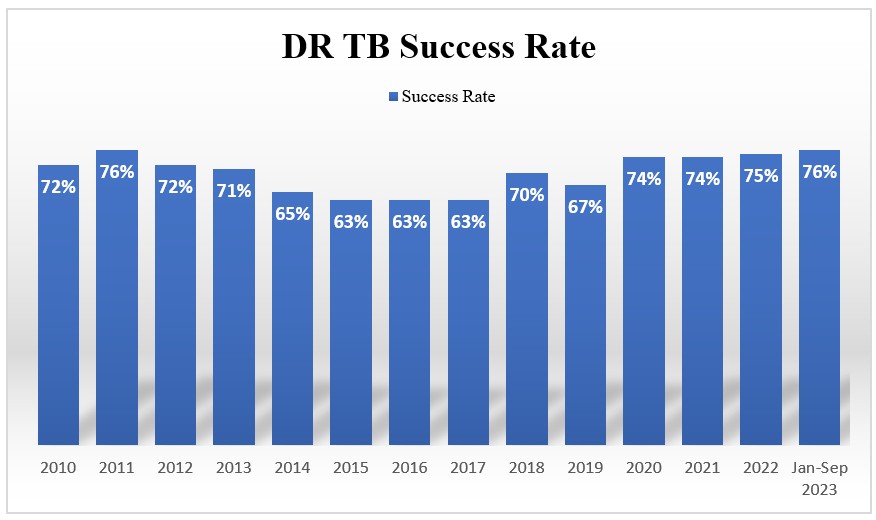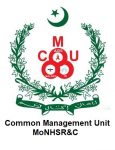PMDT Introduction
Programmatic management of DR-TB treatment started in the year 2010, with identification & the enrollment of 209 RR/MDR-TB patients on second line treatment at 3 treatment sites, in the first year of inception. PMDT treatment sites have increased from 3 to 76 over the period of 15 years, covering all 4 provinces and 3 regions (AJ&K, GB, and ICT) of Pakistan. National TB control program-Pakistan, in liaison with the provincial TB control programs and the associated partners plans for further decentralization of DR-TB care, to cover all the districts of Pakistan.
Objectives
The MDR-TB Program in Pakistan, supervised by the NTP-Pakistan, aims to address the growing challenge of drug-resistant TB through a comprehensive approach. The key objectives of the program include:
- Early Detection and Diagnosis:
- Strengthen diagnostic capacity using advanced tools like Xpert MTB/RIF Ultra, Xpert MTB/XDR, and Line Probe Assay (LPA).
- Ensure timely identification of MDR-TB cases to initiate prompt treatment.
- Effective Treatment and Management:
- Provide free, standardized, and quality-assured treatment for MDR-TB patients.
- Introduce newer drugs (e.g., Bedaquiline, Delamanid, & Pretomanid), and shorter regimens (e.g., BPaL, BPaLM, & STR) for better outcomes.
- Ensure Directly Observed Therapy (DOT) to improve the compliance & adherence.
- Prevention of Transmission:
- Implement infection control measures in healthcare facilities and communities.
- Conduct contact tracing to identify and screen high-risk individuals.
- Strengthening Health Systems:
- Enhance laboratory networks for rapid and accurate diagnosis.
- Train healthcare workers in MDR-TB case management.
- Improve drug supply chain management to prevent stockouts.
- Community Engagement and Awareness:
- Conduct public awareness campaigns to reduce stigma and promote early healthcare-seeking behavior.
- Engage community health workers in patient support and follow-up.
- Surveillance and Monitoring:
- Strengthen TB surveillance systems for real-time data collection.
- Monitor treatment outcomes (success rates, LTFU, deaths) to assess program effectiveness.
- Partnerships and Funding:
- Collaborate with international organizations (WHO, Global Fund, Stop TB Partnership) for technical and financial support.
- Mobilize domestic resources to sustain the program.
Pakistan’s MDR-TB program aligns with the WHO’s End TB Strategy and aims to reduce the burden of drug-resistant TB through early detection, effective treatment, and preventive measures.
Evolution of Second line treatment regimen in Pakistan 2010-22
Conventional Long Treatment Regimen (LTR) of 24 months including Fluoroquinolones (FQ) and second line injectables (SLI) were used, initially, for the treatment of MDR TB, in line with WHO recommendations. In accordance with WHO recommendations, the national guidelines were updated on a regular basis. DRTB treatment regimens have evolved over the period, from injectable-containing-long-regimen (18-20 months) to shorter 9–11-month treatment containing injectables, and subsequently to all-oral-short 9-11 month regimen, and ultimately to all-oral-short-treatment of 6 months (BPaLM) & 9 months (BPaL).
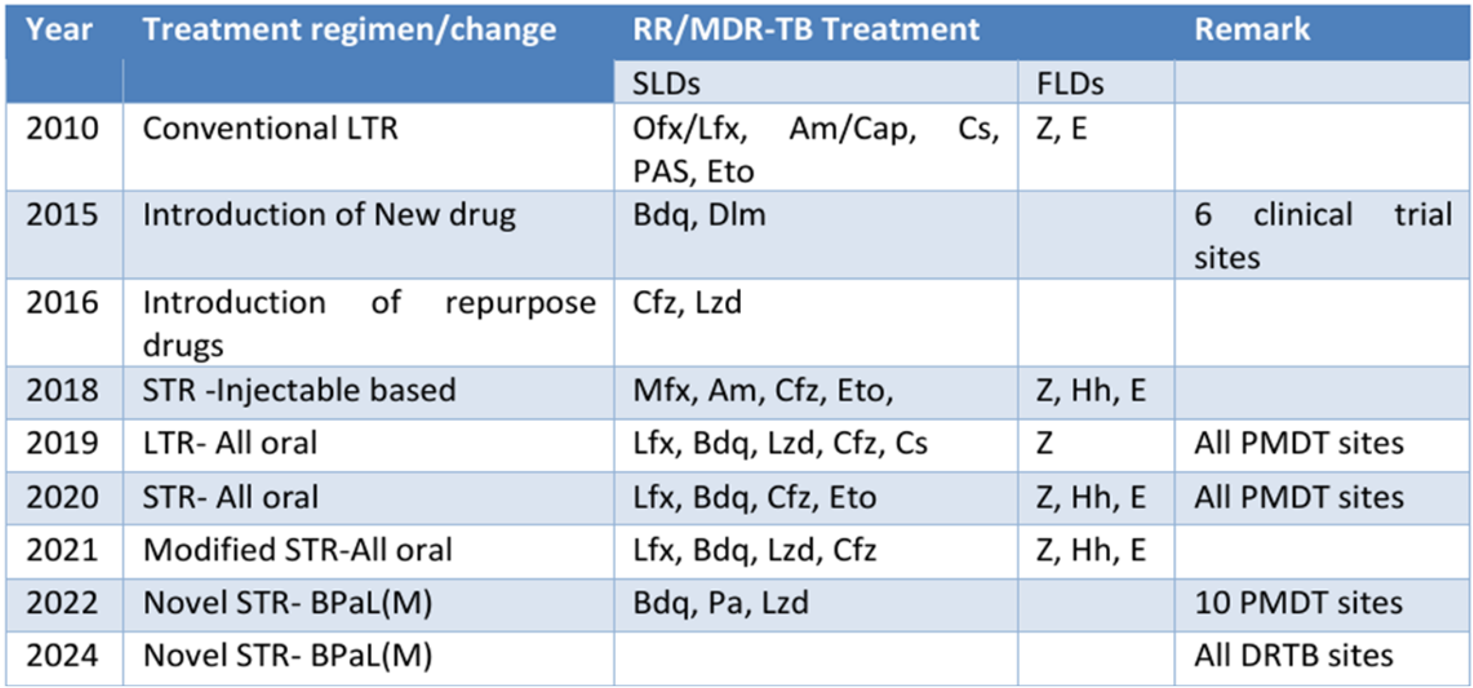
Services
MDR/RR-TB patient diagnosed are referred to DRTB treatment sites where they are offered a package of services including, but not limited to:
- Mycobacteriology diagnostic services (rapid DST, culture DST) • Laboratory diagnostic test for baseline assessment
- Quality assured second line drugs
- Social support (transport and food) for patient and transport-support for the treatment-supporter.
DR-TB treatment options
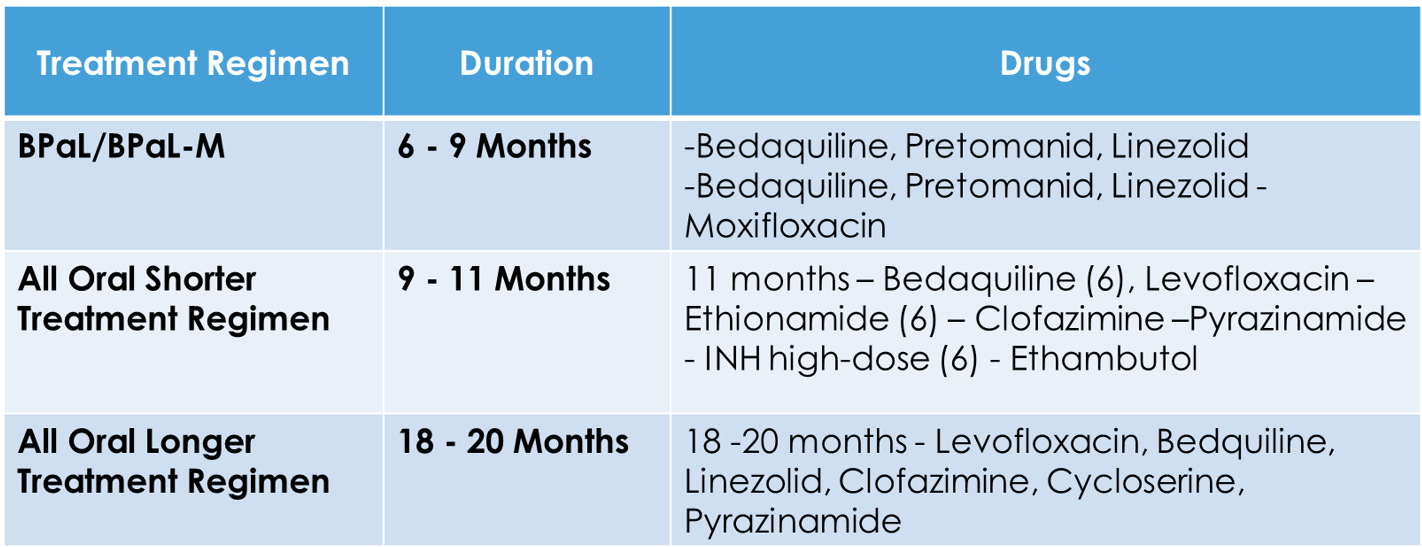
DR-TB Sites in Pakistan
There are 76 DR TB sites located in different parts of the country.
| Details of DR-TB sites - September 2025 | |||||
| Sr# | No. | Province | District | Site Name | Direction |
|---|---|---|---|---|---|
| 1 | 1 | Azad Jammu & Kashmir (AJK) | Muzaffarabad | Abbas Institute of Medical Sciences (AIMS) | Get Directions |
| 2 | 2 | Mirpur | DHQ Mirpur | Get Directions | |
| 3 | 1 | Balochistan | Loralai | DHQ Hospital, Loralai | Get Directions |
| 4 | 2 | Quetta | FJ Chest Hospital, Quetta | Get Directions | |
| 5 | 3 | Hub | Jam Ghulam Qadir Hospital | Get Directions | |
| 6 | 4 | Jaffarabad | DHQ Dera Allah yar | Get Directions | |
| 7 | 5 | Kech (Turbat) | DHQ Turbat | Get Directions | |
| 8 | 6 | Nushki | DHQ Hospital | Get Directions | |
| 9 | 7 | Jhal Magsi | RHC | Get Directions | |
| 10 | 8 | Usta Mohammad | DHQ Hospital | Get Directions | |
| 11 | 9 | Khuzdar | Teaching hospital | Get Directions | |
| 12 | 10 | Qilla Saifullah | DHQ Killa saifullah | Get Directions | |
| 13 | 11 | Qilla Abdullah | DHQ Abdul rehman zai | Get Directions | |
| 14 | 1 | GB | Gilgit | Provincial Headquarter hospital, Gilgit | Get Directions |
| 15 | 1 | ICT | Islamabad | PIMS | Get Directions |
| 16 | 1 | KPK | Abbottabad | ATH Abbottabad | Get Directions |
| 17 | 2 | Peshawar | LRH Peshawar | Get Directions | |
| 18 | 3 | D.I.Khan | MMMTH D.I.Khan | Get Directions | |
| 19 | 4 | Swat | STH Swat | Get Directions | |
| 20 | 5 | Mardan | MMC Mardan | Get Directions | |
| 21 | 6 | Haripur | DHQ Haripur | Get Directions | |
| 22 | 7 | Bannu | KGNTH Bannu | Get Directions | |
| 23 | 8 | Nowshera | DHQ Nowshera | Get Directions | |
| 24 | 9 | Charsadda | DHQ Charsadda | Get Directions | |
| 25 | 10 | Shangla | DHQ Shangla | Get Directions | |
| 26 | 11 | Buner | DHQ Buner | Get Directions | |
| 27 | 12 | Hangu | DHQ Hangu | Get Directions | |
| 28 | 13 | Kohat | DHQ Kohat | Get Directions | |
| 29 | 14 | Lakki Marwat | DHQ Lakki Marwat | Get Directions | |
| 30 | 15 | Dir Lower | DHQ Dir Lower | Get Directions | |
| 31 | 16 | Malakand | DHQ Malakand | Get Directions | |
| 32 | 17 | Mansehra | DHQ Mansehra | Get Directions | |
| 33 | 18 | Chitral | DHQ Chitral | Get Directions | |
| 34 | 19 | Swabi | DHQ Swabi | Get Directions | |
| 35 | 1 | Punjab | Attock | DHQ Hospital | Get Directions |
| 36 | 2 | Bahawalpur | BV Hospital | Get Directions | |
| 37 | 3 | Faisalabad | DHQ Hospital | Get Directions | |
| 38 | 4 | Lahore | Mayo Hospital | Get Directions | |
| 39 | 5 | Jinnah Hospital | Get Directions | ||
| 40 | 6 | Gulab Devi Hospital | Get Directions | ||
| 41 | 7 | Multan | Nishtar Hospital | Get Directions | |
| 42 | 8 | Okara | DHQ Hospital | Get Directions | |
| 43 | 9 | Rahimyar Khan | Sheikh Zayed Hospital | Get Directions | |
| 44 | 10 | Rawalpindi | Samli Sanitorium Murree | Get Directions | |
| 45 | 11 | Rawalpindi Leprosy Hospital | Get Directions | ||
| 46 | 12 | Military Hospital | Get Directions | ||
| 47 | 13 | Sargodha | DHQ Hospital | Get Directions | |
| 48 | 14 | Sheikhupura | DHQ Hospital | Get Directions | |
| 49 | 15 | Sialkot | AIM Hospital | Get Directions | |
| 50 | 16 | Bahawalnagar | DHQ Hospital | Get Directions | |
| 51 | 17 | Chakwal | DHQ Hospital | Get Directions | |
| 52 | 18 | Gujranwala | DHQ Hospital | Get Directions | |
| 53 | 19 | Jhang | DHQ Hospital | Get Directions | |
| 54 | 20 | Kasur | DHQ Hospital | Get Directions | |
| 55 | 21 | Khanewal | DHQ Hospital | Get Directions | |
| 56 | 22 | Layyah | DHQ Hospital | Get Directions | |
| 57 | 23 | Lodhran | DHQ Hospital | Get Directions | |
| 58 | 24 | Mandi Bahauddin | DHQ Hospital | Get Directions | |
| 59 | 25 | Mianwali | DHQ Hospital | Get Directions | |
| 60 | 26 | Vehari | DHQ Hospital | Get Directions | |
| 61 | 1 | Sindh | Badin | DHQ Hospital | Get Directions |
| 62 | 2 | Hyderabad | LUMHS Hyderabad | Get Directions | |
| 63 | 3 | Jacobabad | DHQ Hospital | Get Directions | |
| 64 | 4 | Jamshoro | ICD, Kotri | Get Directions | |
| 65 | 5 | Karachi Malir | NCC -Karachi | Get Directions | |
| 66 | 6 | Karachi-East | OICD, Hospital | Get Directions | |
| 67 | 7 | Karachi-Korangi | Indus Hospital | Get Directions | |
| 68 | 8 | Karachi-South | JPMC Hospital | Get Directions | |
| 69 | 9 | Khairpur | TB Hospital | Get Directions | |
| 70 | 10 | Larkana | CMC Hospital | Get Directions | |
| 71 | 11 | Mirpurkhas | DHQ Hospital | Get Directions | |
| 72 | 12 | Nawabshah (SBNB) | PMC Hospital | Get Directions | |
| 73 | 13 | Qamber Shahdad Kot | DHQ Kambar Shahdadkot | Get Directions | |
| 74 | 14 | Sanghar | DHQ Sanghar / CH Sanghar | Get Directions | |
| 75 | 15 | Sukkur | GMM, Hospital | Get Directions | |
| 76 | 16 | Tharparkar | DHQ Hospital, Mithi | Get Directions | |
Provincial breakup of number of DR TB Sites in Pakistan till September 2025
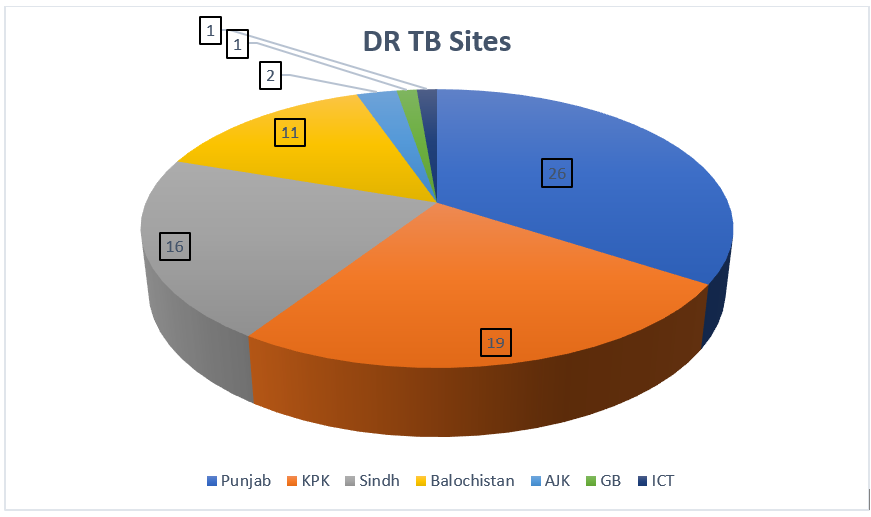
DR TB treatment sites and enrolment
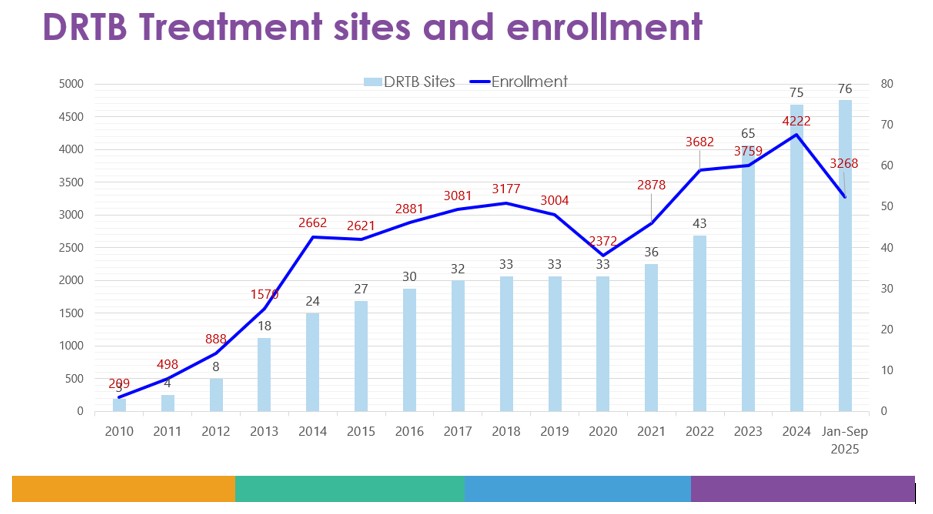
Treatment outcomes
